September 25, 2009
Air Date: September 25, 2009
FULL SHOW
SEGMENTS
View the page for this story
US President Barack Obama and Chinese President Hu Jintao topped the list of world leaders to speak at the recent United NationÂ’s climate summit, which also included eloquent pleas from Maldives President Mohamed Nasheed and UN Secretary-General Ban Ki-Moon. President Hu's announcement on ChinaÂ’s commitment to renewable energy and improving efficiency stole the show. But not everyone was impressed with ChinaÂ’s pledge. Elizabeth Economy is the director for Asia Studies at the Council on Foreign Relations. Host Steve Curwood asks her why sheÂ’s skeptical of ChinaÂ’s climate fanfare. (06:30)
Survivaball of the Fittest
View the page for this story
While delegates at the UN Climate Summit discussed options for avoiding climate disaster, some novel thinkers planned for the worst. The activist prankster duo, the Yes Men, unveiled a new product- the Survivaball - a six foot wide inflatable suit designed to weather all impending natural catastrophes. Host Jeff Young speaks with Yes Man Mike Bonanno. (03:00)
Fossil Fuel Subsidies
View the page for this story
At the recent G20 Summit in Pittsburgh, President Obama stated the importance of taking a hard look at fossil fuel subsidies. New reports suggest these subsidies contribute to global warming by encouraging the production of cheap fuels. Host Jeff Young talks with Stephen Kretzmann, the director of Oil Change International, about the PresidentÂ’s proposal. ()
/ Elise PotakaView the page for this story
The Laos government has set a goal to reforest their nation. These plans have meant some rice farmers have to reduce their field acreage and let steep slopes grow trees instead of crops. Now, scientists are working with farmers to produce profitable harvests by finding higher yielding varieties of the rice that Laotians prefer - sticky rice. Reporter Elise Potaka reports. (06:20)
Green Intelligence
View the page for this story
In the 1950Â’s scientists began to realize that fallout from nuclear testing was moving through the environment and up the food chain. Since that point, it seems that each year another chemical substance is found to be toxic and then pulled off the market only to be replaced by a slew of other chemicals. John Wargo is a professor of environmental policy and risk analysis at Yale University. He talks with host Steve Curwood about his new book, Green Intelligence: Creating Environments that Protect Human Health, and explains which chemicals threaten us and how the government can better protect us from these risks. (05:20)
Emerging Science Note Polar Bears
/ Lisa SongView the page for this story
Inuit trackers can trace polar bears based on a single paw print, and DNA technology can identify individual bears. Lisa Song reports on biologists who combine both methods to monitor bear populations. (01:45)
Vanishing Aspens
View the page for this story
Scientists report that drought conditions in the Rocky Mountain West are contributing to SAD, Sudden Aspen Decline. (05:50)
Language of Landscape
/ Donna SeamanView the page for this story
Living on Earth continues its series exploring features of the American landscape. It’s based on the book “Home Ground: Language for an American Landscape,” edited by Barry Lopez and Debra Gwartney. In this installment, Donna Seaman explains the term “chop hills.” (02:10)
A Tale of Two Seals
View the page for this story
There once was a famous seal named Hoover who lived in the BostonÂ’s New England Aquarium and spoke English. Now, his grandson Chuck carries that torch, bridging the language barrier between the seal and human world. Living on EarthÂ’s Ike Sriskandarajah goes to the aquarium to talk with the animals. (06:30)
This week's EarthEar selection
listen /
download
Show Credits and Funders
Show Transcript
HOSTS: Steve Curwood, Jeff Young
GUESTS: Elizabeth Economy, Mike Bonano, Steve Kretzman, John Wargo, Jim Worrall
REPORTERS: Elise Potaka, Ike Sriskandarajah
NOTE: Lisa Song
CONTRUBITOR: Donna Seaman
[THEME]
CURWOOD: From Public Radio International - this is Living on Earth.
[THEME]
CURWOOD: I'm Steve Curwood.
YOUNG: And IÂ’m Jeff Young. The UN focuses on climate change. ChinaÂ’s President Hu Jintao steps up to the plate and gets international applause. But not all are impressed.
ECONOMY: IÂ’m frankly a little bit surprised by all of the hype. What weÂ’ve gotten from President Hu Jintao is pretty much what the president has been saying for the past three or four years, frankly speaking.
YOUNG: And we talk to the makers of Survivaball, a new product to keep you safe from the ravages of global warming.
CURWOOD: Plus, a wildlife icon and an aquariumÂ’s ambassador to the world.
GRAHAM: Hoover was a very famous seal here in Boston. He was on TV a couple timesÂ…and he was famous for talking.
[HOOVER TALKING]
CURWOOD: (Laughing) Hoover, the talking seal, and how his talent lives on. We have those stories and more this week on Living on Earth, so stick around!
ANNOUNCER: Support for Living on Earth comes from the National Science Foundation and Stonyfield Farm.
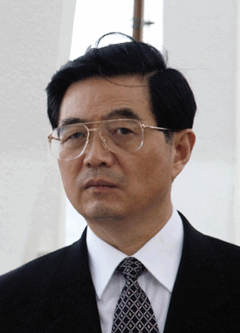
Hu Jintao, who has been President of China since 2003, is praised for his reserved, low-key leadership style.
CURWOOD: From the Jennifer and Ted Stanley studios in Somerville, Massachusetts, this is Living on Earth. IÂ’m Steve Curwood.
YOUNG: And IÂ’m Jeff Young. The UN has been talking for years about what its scientists call the dire threat from global climate change, but for the first time the leaders of the biggest emitters of greenhouse gases -- China and the United States -- stood on the same platform to offer their solutions. The occasion was a climate summit at the United Nations.
CURWOOD: Mohamed Nasheed, the president of one of the worldÂ’s smallest nations --- the low-lying Maldive Islands -- set the tone of the summit as he called on the worlds most polluting nations take action. Otherwise, according to scientists, ice will melt, tropical storms, floods and droughts will increase, and sea level will rise sharply.
NASHEED: If things go business as usual, we will not live, we will die. Our country will not exist. We cannot come out from Copenhagen as failures. We cannot make Copenhagen a pact for suicide.
YOUNG: Speaking for the developed nations, President Barack Obama added his own sense of urgency.
OBAMA: The threat from climate change is serious, it is urgent, and it is growing. Our generation’s response to this challenge will be judged by history, for if we fail to meet it—boldly, swiftly, and together—we risk consigning future generations to an irreversible catastrophe.
YOUNG: China has now passed the United States as the worldÂ’s biggest emitter of greenhouse gases. Together, the two create 40 percent of the global total.
[HU JINTAO SPEAKING CHINESE; TRANSLATOR SPEAKING “MR. SECRETARY GENERAL, DEAR COLLEAGUES…”]

Hu Jintao, who has been President of China since 2003, is praised for his reserved, low-key leadership style.
YOUNG: Speaking through an interpreter, Chinese President Hu Jintao emphasized that his country was already cleaning up its act, by improving energy efficiency, increasing carbon-free energy production and soaking up global warming gases with forest growth.
CURWOOD: While President Hu did not pledge to put caps on his countryÂ’s overall green house gas emissions, he did commit to reducing carbon intensity, by quote, a notable margin. The speech prompted some, including UN Climate Chief Yvo de Boer to, quote, commend China for its leadership.
But Elizabeth Economy was not so impressed. She is an author on environmental issues in China and the Director for the Asian program at the Council on Foreign Relations, and she says ChinaÂ’s commitments did not go far enough.
ECONOMY: Well, I think that President Hu Jintao has brought a positive attitude (laugh) toward being a responsible player, a responsible partner to address the challenge of global climate change. I donÂ’t think that heÂ’s brought to the table what the Europeans, or the Japanese, or the United States even, really wants to see coming out of China, which is namely a pledge or promise to cap emissions even at some point further down the line.
Instead what weÂ’ve gotten from President Hu Jintao is pretty much what he said before, which is that he will promise to curb the growth of ChinaÂ’s carbon dioxide emissions, he will continue with an aforestation program, and he will pursue the development of renewable energy within the countryÂ’s energy mix to try to obtain a goal of about 15 percent by 2020.
CURWOOD: So, what do you make of this report from the International Energy Agency that says, in essence, that China will move towards a forefront of combating climate change by 2020, if it meets its own stated targets that Hu Jintao presented on greenhouse gas emissions?

China's energy consumption has been steadily growing by 7% annually.
ECONOMY: I guess IÂ’m puzzled by that because again the President Hu Jintao has not made any commitments in terms of reducing greenhouse gas emissions. The only pledge that heÂ’s made is to get, you know, the role of renewables within the countryÂ’s energy mix up to 15 percent by 2020, and I donÂ’t think that will put them at the forefront of combating climate change.
CURWOOD: I think that more or less direct quote from the IEAÂ’s chief economists says, quote, if China reaches its target, and in the past it has reached most of its targets of this kind, its emissions growth will have declined so much by 2020 that it will be the country that has achieved the largest emissions reductions.
ECONOMY: (Laugh) Well, I think the only other possible explanation is that in many instances the International Energy Agency, the United Nations, have been very much cheerleaders for China – encouraging them even as they take the smallest steps toward meeting their environmental or climate goals. Again, since they haven’t made any commitments, it is very difficult to understand exactly what the chief economist is talking about.
CURWOOD: So, letÂ’s look at what he had in the speech. President Hu said weÂ’ll develop renewable energy, nuclear energy. WeÂ’ll endeavor to increase the share of non-fossil fuels and primary energy consumption to around 15 percent by 2020. How does that compare to what the United States and Europe are doing?
ECONOMY: Again, I think this is important, what President Hu Jintao is saying, to have 15 percent of their energy come from nuclear and renewable. But, if the Chinese economy continues to grow at a rate of, you know, eight percent or seven percent per year. Back in 2000, people were predicting that they would double their energy consumption by 2020. Instead, China doubled its energy consumption by 2007.
So, just the sheer rate at which this enormous economy is growing means that even if you have 15 percent of your energy mix coming from renewables, if youÂ’re doubling the size of your economy and your energy along with it, youÂ’re really looking at an enormous increase in the use of fossil fuels.
CURWOOD: LetÂ’s talk about the use of fossil fuels. ThereÂ’s a saying that every week China builds another coal-fired power plant. How accurate is that?
ECONOMY: I think it was true, probably about two years ago; every seven to ten days China was putting online a new coal-fired power plant. It may still be true. I think the important thing to realize is these coal-fired power plants are more efficient than the ones that they are replacing. And so, thatÂ’s a plus, but at the same time, you are seeing an overall increase in the amount of energy consumed, in the energy demand in the country.
CURWOOD: So, letÂ’s circle around back now to Copenhagen. Coming into Copenhagen, handicap for me how well the Chinese will do with what theyÂ’ve put out on offer so far, and how well the US will do, and what might that mean for climate politics going forward?
ECONOMY: You know, my sense is that no country is going to get what it wants. WeÂ’re unlikely to come to any real, global agreement. Optimally, we would see within the US Senate movement suggesting that Waxman-Markey, or some variant thereof, has a very good chance of making it through, and President Obama and his team can be confident that what they bring to Copenhagen is going to be something substantial.
On the Chinese side, you know, optimally theyÂ’re going to move forward from what weÂ’ve heard from President Hu Jintao and actually say as they said in a study that came out in August, yes, letÂ’s set some voluntary targets first, and then letÂ’s set into place some binding targets. So, some kind of time frame, I think, from the Chinese for actual reductions in emissions would be the optimal end result.
CURWOOD: Even if that number isn’t say, ‘til 2030. That China says, well, we’ll keep growing until 2030, that’s when we’ll finally start shrinking.
ECONOMY: I think even if they say we’re going to allow emissions to peak around 2030 and then set firm targets for reduction, I think that gives the rest of the global community a much firmer place from which to – to push the Chinese and from which to negotiate, and I think that’s precisely why the Chinese have not done it.
CURWOOD: Elizabeth Economy is the director of the Asian program at the Counsel on Foreign Relations, and is working on a new book about China. Thank you so much, Elizabeth.
ECONOMY: Thank you.
Related links:
- Click Here to Hear Barack Obama's Speech at the UN
- Click Here to Hear Mohamed Naheed's Speech at the UN
- Click Here to Hear Ban Ki Moon's Speech at the UN
- Click Here to Hear Hu Jintao's Speech at the UN
[MUSIC: Tom Verlaine “Little Dance” from ‘Warm And Cool’ (Thrill Records - 1992)]
CURWOOD: Coming up, a new take on the green revolution for rice farmers in South Asia. Keep listening to Living on Earth!
Survivaball of the Fittest

The Yes Men are Andy Bichlbaum and Mike Bonanno
YOUNG: Amid all the gloomy global warming scenarios of rising seas and fierce storms, one company offers a way out. Not far from the United Nations building in New York the company showed off a product advertised as the individualÂ’s way to guard against the ravages of climate change. ItÂ’s called Survivaball.
[SURVIVABALL COMMERCIAL; WOMAN SAYING, “EACH SURVIVABALL CONTAINS ALL THE TOOLS YOU NEED TO ENJOY A SAFE AND HAPPY STAY ON OUR CHANGING PLANET...”]
YOUNG: We caught up with one of the developers of Survivaball, Mike Bonano, for more on his intriguing product.
BONANO: With climate change coming and bringing all kinds of disasters, there has got to be a way to save all these CEOs who are creating the problem. And Survivaball is the answer – it’s a gated community for one. A survival suit six-feet in diameter that can contain a single individual and sustain them, even when everybody else is dead.
YOUNG: Now, youÂ’ve actually had a demonstration of the Survivaball, youÂ’ve tried floating them out into the East river in New York?

In a scene from their new movie, The Yes Men Change the World, Mike and Andy demonstrate how the Survivaball can be used in common leisure activities. (Photo by theyesmen.org)
BONANO: Absolutely. All week weÂ’ve been using Survivaballs in New York and the lead up to the big climate negotiations at the U.N. We had 21 of them that were planning to enter the East river and float up to the U.N. and basically sit in on the negotiations, but unfortunately the police came right away and turned us back. And, Andy was arrested.
YOUNG: Andy is your partner and we should probably reveal at this point youÂ’re actually part of the prankster duo known as the Yes Men.
BONANO: Ah, yes. I guess I let the cat out of the bag, didnÂ’t I?
YOUNG: (Laughing) WhatÂ’s the point of doing Survivaball?
BONANO: Well, you know, we want to highlight what is the primary problem that the civilization faces at the moment, which is climate change. And sometimes doing it with a little bit of humor goes to places that the serious and dire messages donÂ’t.
And so, you know, itÂ’s funny, it attracts attention and when people are in these Survivaball costumes, itÂ’s really hard for the police to figure out what to do about it, because thereÂ’s no place to really grab onto the them. They donÂ’t really know where the person is inside the costume. So itÂ’s a great, and strange, and funny costume to get in for acts of civil disobedience.

The Yes Men are Andy Bichlbaum and Mike Bonanno
YOUNG: Have you had anyone take you up on this, and say, I like this idea. Where can I get one?
BONANO: Oh, yes, in fact the first time we made them was because we were representing Halliburton at a catastrophic loss conference and the audience of insurance industry reps actually applauded and several of them were interested in it.
YOUNG: So, youÂ’ve had that, and youÂ’d think thatÂ’d be enough. But for this week in New York when the worldÂ’s attention was focused on climate change, you decided to print a newspaper that would be focused on the news about climate change.
BONANO: That’s right. We worked with a bunch of other activist organizations and we put together a fake New York Post, and the headline there is “We’re Screwed: What you’re not being told; official city reports massive climate catastrophes, public health disasters.”
And everything in this fake Post is absolutely true. What we see is that papers like the Post donÂ’t give adequate coverage to climate change, and since they werenÂ’t doing it, we took matters into our own hands.
YOUNG: Is it hard to find the funny in climate change?
BONANO: Well, you know, it is incredible depressing because itÂ’s incredibly scary, but you know, it is easy to see the funny in a black humor sort of way, because our approach to it is so absurd. You know, like having technical solutions to climate change, when we know exactly what we need to do, and that is reduce emissions.
YOUNG: Mike Bonano is one half of the Yes Men. Thanks for your time.
BONANO: Thank you!
Related link:
The Yes Men
[MUSIC: Tom Verlaine “Little Dance” from ‘Warm And Cool’ (Thrill Records - 1992)]
CURWOOD: Coming up, a new take on the green revolution for rice farmers in South Asia. Keep listening to Living on Earth!
Fossil Fuel Subsidies

G20 Logo
CURWOOD: ItÂ’s Living on Earth. IÂ’m Steve Curwood.
YOUNG: And IÂ’m Jeff Young. At the G20 economic summit in Pittsburgh, President Obama challenged other world leaders to take a fresh look at the support their governments give to fossil fuels.
OBAMA: I will work with my colleagues at the G20 to phase out fossil fuel subsidies so that we can better address our climate challenge.
YOUNG: Recent reports from the International Energy Agency and other institutions point out the scale of those largely hidden subsidies and how they contribute to global warming.
ItÂ’s an area Steve KretzmanÂ’s studied for decades at the Institute for Policy Studies and now with the advocacy group Oil Change International. So I asked Mr. Kretzman what exactly these subsidies are.
KRETZMAN: This is basically money thatÂ’s given by governments to either subsidize the cost of production, thus lowering the cost of production for producers like oil and coal, or subsidize the cost of consumption, thus lowering the cost of consumption for consumers around the world, i.e., keeping the price of gas artificially low.
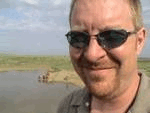
Steve Kretzmann is the Executive Director of Oil Change International
YOUNG: So give us a sense of the scale – how much money are we talking about?
KRETZMAN: On an annual basis, globally, there are at least $250 billion dollars in global fossil fuel subsides, and some people will think that number is closer to $400 billion.
YOUNG: And these are mostly, what in the form of tax breaks, or direct payments, or what?
KRETZMAN: Most of the subsidies are on the consumption side, keeping the price of gas low and the price of energy affordable for people in developing nations. But, thereÂ’s also some very substantial subsidies on the production side, predominately in the United States and Europe. In the US, thereÂ’s a great study that came out last week that shows that we give at least $70 billion dollars on an annual basis to the fossil fuel industry.
YOUNG: And how does that level of subsidization compare to what we give to say, uh, renewable energies: wind, solar, things like that.
KRETZMAN: We still subsidize fossil fuels at a much higher rate than we do true renewables. You know, solar, wind, efficiency, these things get about 12 billion on an annual basis, as compared again to 70 for fossil fuels. So that’s a really imbalanced energy market. A few years back, there was a study of climate change, in particular, and it was noted by Nicholas Stern, who was the World Bank’s chief economist, that climate change is the greatest market failure of all time, and that the subsidies – the fossil fuel subsidies – are the major reason for this market distortion.
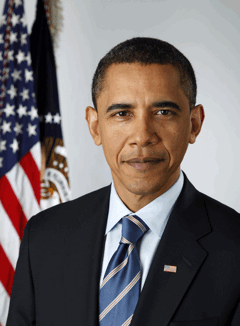
President Obama
YOUNG: Well, the PresidentÂ’s proposal got a pretty immediate response from some oil-producing states. HereÂ’s what Senator Lisa Murkowski, Republican from Alaska, had to say.
MURKOWSKI: I think it is important to determine what is a subsidy and what is a tax incentive. Raising taxes on the fuels that we currently depend on would likely result in higher consumer prices and would only impact our ability to produce those fuels domestically instead of importing them.
YOUNG: What do you make of that statement from Senator Murkowski?
KRETZMAN: First of all, IÂ’m not really sure why the industry would need additional incentive. This is one of the most profitable industries on the planet, and why they need to use tax dollars to additionally incentivize them doesnÂ’t really make any sense. And itÂ’s time to start using our public money to encourage the energy of the future, not the energy of the past.
YOUNG: But, it seems to me she does hit on a couple of key concerns here that are valid. ThereÂ’s the very real likelihood that this would result in increased prices for consumers.
KRETZMAN: I think access to energy and access to the services that energy provides – transport, light, heat, etc. – is very important and it’s something that we wanna absolutely guarantee and help to facilitate for all people. How that energy gets generated is not really something that most people are attached to. Most people don’t really care that they’re, you know, lighting their or heating their, homes with a coal-fire power plant as opposed to a centralized solar power plant.
YOUNG: They donÂ’t care where it comes from, but they care how much it costs, and if you yank these subsidies out from under them, itÂ’s going to cost more, isnÂ’t it?

KRETZMAN: Well, it depends. If you effect a transition time, and at the same point youÂ’re subsidizing the cleaner energy production, maybe you end up actually with cheaper energy on the other end. I think everyone recognizes that itÂ’s in no oneÂ’s interest to jack up the price and make energy or transport unaffordable to Americans or anyone else in the rest of the world. What we want to do is make sure this energy is actually produced in a clean way that is sustainable.
YOUNG: And what about the notion that we would just encourage more import rather than domestic production of oil?
KRETZMAN: The oil industry has every incentive to find more oil domestically because itÂ’s much cheaper to transport it if you produce it domestically, and bring it to market in the United States, which is the largest oil market in the world. ThatÂ’s going to give them much higher profit margins, and thatÂ’s all the incentive they need.
YOUNG: Give me a sense of why this matters for climate change. What kind of greenhouse gas emissions are really buried in these subsidies, in these tax breaks?
KRETZMAN: The greenhouse gas implications of this proposal to remove subsidies are actually quite profound. There was a study from OECD earlier this year that showed that for the $300 billion dollars in subsidies that were identified in that study, if they were taken away, you would get a 10 to 12 percent reduction, globally, in greenhouse gases.
YOUNG: Steve Kretzman is with the group Oil Change International. Thanks for your time.
KRETZMAN: Thanks very much for having me.
Related links:
- For more information on Oil Change International, click here
-
[MUSIC: Josh Roseman “Satta Massagana” from ‘New Constellations’ (Enja Records - 2007)]
CURWOOD: In the landlocked Southeast Asian country of Laos, rice is central to the diet. The average Laotian eats about 350 pounds of rice each year - thatÂ’s over two-thirds of their calorie intake. Since rice is so vital for the nationÂ’s food security, the Laotian government has worked hard to achieve self-sufficiency in the crop. The efforts have been successful. In 2001, the country stopped importing rice from its neighbors - a great achievement for a small, under-developed nation. But, as Elise Potaka finds out, rice farmers in Laos still face challenges ahead.
[SHOVEL DIGGING DIRT]
POTAKA: In Fai Village, not far from Luang Prabang, the rice fields have been harvested and are being prepared for next seasonÂ’s crop. ItÂ’s been a tough year for FaiÂ’s farmers, like Xiang Lar.
[LAR SPEAKING LAOTIAN]
VOICEOVER: Last year, my rice production was 50 bags, but this year itÂ’s only 25 bags.
[WOMEN AND MEN TALKING]
POTAKA: Xieng Lar and other farmers say they lost their first crop to rodents and had to sow a second.
[VILLAGE SOUNDS]
POTAKA: But rodents are only one of the challenges facing LaosÂ’ rice farmers in their efforts to maintain their rice yields. In 2005, the government adopted a new forestry strategy aimed at increasing forest cover to 70 percent by 2020. The government says it wants to more sustainably manage the countryÂ’s forests. Now, shifting cultivation and slash and burn agriculture are being phased out. Banthasack Vongphuthone, from the National Agriculture and Forestry Research Institute or NAFRI, says this has had a big impact.
[VONGPHUTHONE SPEAKING LAOTIAN]
VOICEOVER: Now land is allocated to individual farmers. Households receive around 1.5 hectares on which to cultivate crops. But in many cases there has been a loss of soil fertility, because farmers can no longer rotate their crops. They have to plant rice in the same field every year.
POTAKA: Banthasack Vongphuthone and his institute have been working with the International Rice Research Institute, or IRRI, to try and help farmers maintain their yields. Researchers, alongside villagers and local government, are experimenting with rice varieties to see which ones grow best under these new conditions. Dr. Ben Sampson is based in Luang Prabang with IRRI.
SAMPSON: My predecessors have worked on identifying cultivars, which will grow under continuous rice cultivation. Cultivars which will be able to grow in such a way that they grow fast and are harvested early, so that it allows for another crop to grow.
POTAKA: Most of the plants used in the experiments are local Laos cultivars, that is, seed varieties selected by Laotians over many years for their strength, flavor and other beneficial features. The experiments start with a choice of around 100 varieties, but through interaction with farmers this is narrowed down. Banthasack Vongphuthone says the rice with the highest yield is not always peopleÂ’s favorite.
[VONGPHUTONE SPEAKING ENGLISH]
VOICEOVER: Some varieties are high yield, but the grain is small. For example, for the cooking itÂ’s not good, not soft. We have the farmer field days. We invite the farmers to look at the varieties. We try five or six varieties, what is the best one for you or the village. And they select and choose.
[ROOSTER CROWS; ENGINE SOUNDS]
POTAKA: While IRRI offers farmers all different types of rice, most people here want glutinous or sticky rice varieties. The Laos style of eating uses sticky balls of rice and no chopsticks, and Dr. Ben Sampson says farmers can at first be reluctant to grow non-glutinous rice.
SAMPSON: They come and evaluate the material and say this looks good, it has the right grains size, it looks nice. But then they ask us, is it glutinous, is it non-glutinous? If itÂ’s non-glutinous, then I donÂ’t like it, I donÂ’t want it!
On the other hand weÂ’ve also come across farmers who have big families, this one farmer I remember in Udom Xay Province. He told us that since he started growing non-glutinous rice, heÂ’s been able to cut down the number of months where they donÂ’t have rice in their household. HeÂ’s been able to plant rubber on his upland area.
POTAKA: To try and cater to the demand for glutinous rice, researchers from IRRI are now collecting Laos rice varieties for the international rice gene bank at the IRRI headquarters in the Philippines. Laos is now the second biggest contributor to the gene bank and there are plans to develop a specific breeding program for sticky rice varieties.
[VOICES LAUGHING; VILLAGE SOUNDS]
POTAKA: Back in Fai village, villagers are called into the meeting hall over an ancient-looking sound system. TheyÂ’ve come to discuss the outcomes from their latest work with IRRI. Generally, the higher yields are being seen in the lowland fields, and this means that farmers can now use any remaining upland or sloping areas for crops to sell. Mai Joy is the village head.
[JOY SPEAKING LAOTIAN]
VOICEOVER: Ten years ago, we only grew rice and rice products, but now we grow cash crops like sesame, corn and a local type of maize. We also grow banana and sugar cane, and any leftover space in the paddy fields can be used as household gardens.
POTAKA: For LaosÂ’ subsistence farmers, being able to generate cash is a big change. On the one hand, it offers them the chance to buy necessities and to pay for a better standard of health care and education. But Dr. Sampson says that it could also lead to the use of chemical pesticides and fertilizers.
[ANIMAL SQUAWKING]
POTAKA: Here in Fai Village, theyÂ’re experimenting with natural fertilizers like green manure to try and improve their soils. Researchers hope that this, along with education programs, will discourage the abuse of chemicals as LaosÂ’ farmers work to maintain their yields. In Luang Prabang, IÂ’m Elise Potaka for Living on Earth.
[SHOVEL DIGGING DIRT]
Green Intelligence

Green Intelligence: Creating Environments that Protect Human Health
CURWOOD: As emerging agricultural economies in countries like Laos become increasingly reliant on chemicals, they are beginning to face many of the same risks as those in the industrialized world. But figuring out those risks can be confusing and difficult. Living on Earth regularly reports on the suspected dangers of particular compounds, but it’s hard to know how fearful to be about the thousands of untested and poorly understood substances. Maybe we need some “Green Intelligence.”
WARGO: The purpose of the book is really to underscore the absence of understanding about what's worth worrying about.
CURWOOD: That’s John Wargo, Yale professor of environmental policy and risk analysis, who’s written the book “Green Intelligence” for the general public. His aim is to provide a comprehensive guide to both the health dangers as well as the political challenges of addressing those dangers.
WARGO: Most people donÂ’t understand what theyÂ’re exposed to and where it comes from and it arises from a number of different reasons. The failure to produce and disseminate knowledge, the existence of trade secrecy on the part of the private sector, and also classified information on the part of the government. But also the absence of transparency of knowledge that groups like EPA have, but do not make accessible to the general public.
CURWOOD: You say that trade secrecy really jeopardizes our safety. How does that work?
WARGO: I think trade secrecy is very similar to classified information, in that the primary purpose is to protect competitive advantage, but it has the effect of keeping critical information from consumers about product ingredients.
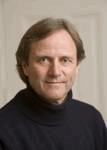
John Wargo
A good example would be a plastic water bottle. TheyÂ’re labeled on the bottom with a recycling code of number seven, but the number seven also includes many other different kinds of plastics, so it gives the consumer no understanding of whether or not the polycarbonate contains a chemical known as bisphenol A. So, itÂ’s difficult then for individuals to think about how they would avoid chemicals in everyday consumer products.
CURWOOD: Now the EPA is supposed to be protecting both the environment and human health, but you assert in your book that itÂ’s failing in its mission.
WARGO: Well, I think it has. I think EPA has done a good job when it has targeted emitters of smokestack or pipe pollution into surface waters, but where they have really fallen down has been in the management of chemicals that are components of consumer products or chemicals that are waste products.
For example, there are now 80,000 chemicals in international commerce. Fewer than ten percent of these have been tested to understand their behavior once released to the environment, or what kinds of effects they might cause on human health, so that perhaps only two or three percent of those 80 to a 100,000 chemicals have been tested fully for the range of toxic effects that are now required by law. WeÂ’re in a position where weÂ’re playing catch up and what the effects of these chemicals are, singly, but also in combinations on human health.
CURWOOD: How much trouble are we in as a society, as a planet, from toxic exposure to chemicals? How serious is this problem?
WARGO: Well, my opinion is that itÂ’s very serious. And IÂ’m not happy about the fact that my children are walking around with this body burden of synthetic chemical substances. And I think that there is growing evidence that some of the health effects that we see, including the rise of respiratory illness, has raised the alarm for me. And the real purpose of the book is to explore the underlying factor that led to the problem of overexposure and under-attention.

Green Intelligence: Creating Environments that Protect Human Health
CURWOOD: So, someone listening to us would say, yeah, yeah, yeah, I heard all this. In fact, my car pollutes, the smokestack down the street pollutes, the stuff I buy at the grocery store comes with pesticides. I mean, whatÂ’s a human being to do?
WARGO: Well, I think that there are a number of things that and individual or a family could do. They could adjust their behavior by really changing the way that they think about chemicals in their environment. For example, there are simple things you can do to ensure that you have higher air quality indoors. It’s very important to carefully understand what is being sprayed on – in an indoor environment. Research that I’ve done has demonstrated that often chemical penetrations are higher in indoor environments and exposures are higher when an indoor environment is sprayed and then occupied.
So, be very, very careful and cautious about pesticide use indoors. I recently purchased a flea powder, for example, and there was a plastic bottle, and on the surface of the plastic bottle was a plastic wrapping. And the plastic wrapping claimed that the product was safe for humans and safe for animals. Well, I took the plastic wrapping off and I looked beneath it, and the EPA-required pesticide label stated that it was hazardous to humans, and potentially hazardous to pets, unless the requirements on the label were met very strictly for what the concentration ought to be and how to avoid touching the skin with the product. And this, I think, leads to exposures.
CURWOOD: Now someone listening to us talk might decide that, well, Professor WargoÂ’s just plain anti-chemical. How true is that?
WARGO: Not at all. Chemicals are necessary for life – we’re all made of chemicals. There are chemicals that are essential nutrients, but there are also chemicals that behave in ways that threaten human health. And my argument in the book is basically that we need a better way to be able to distinguish between the chemicals necessary for healthy life, and those that threaten it.
CURWOOD: John Wargo’s book is called “Green Intelligence: Creating Environments that Protect Human Health.” Thank you so much for taking this time.
WARGO: No, thank you very much, Steve, for your interest.
[MUSIC: Thievery Corporation “Retaliation Suite” from ‘Radio Retaliation’ (ESL Music - 2008)]
YOUNG: Just ahead, the amazing tale of a talking seal. Stay with us on Living on Earth.
ANNOUNCER: Support for the environmental health desk at Living On Earth comes from the Cedar Tree Foundation. Support also comes from the Richard and Rhoda Goldman fund for coverage of population and the environment. And from Gilman Ordway for coverage of conservation and environmental change. This is Living On Earth on PRI, Public Radio International.
Emerging Science Note Polar Bears
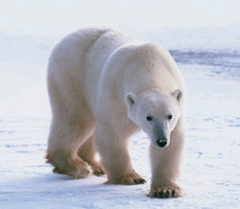
(Courtesy of USGS)
YOUNG: ItÂ’s Living on Earth. IÂ’m Jeff Young.
CURWOOD: And IÂ’m Steve Curwood. Just ahead, a sad phenomenon in the Pacific Northwest, but first this note on emerging science from Lisa Song.
[THEME MUSIC]
SONG: As climate change thaws the Arctic, itÂ’s more important than ever to keep an eye on polar bears. Scientists are now turning to Inuit expertise to monitor bear populations. For Inuit hunters, a single paw print can reveal a polar bear's sex, age, and size. The expert trackers will help researchers study polar bear movements and the accuracy of those skills will be tested by Canadian scientists.
At the same time, scientists will build fences around pieces of meat used as bait. As polar bears dine on the meat, bits of fur will get trapped on the fence, and biologists can use DNA markers from the hair to identify individual bears. Bear droppings will also be collected to study for signs of disease.

(Courtesy of USGS)
Currently, researchers follow bears in helicopters and inject them with tranquilizers before tagging the animals for study. The new system is cheaper and more humane. It also helps economic development. The Inuit hunters will work from cabins in the far north, close to Baffin Island. When not being used for research, the cabins can be rented by eco-tourists.
Scientists hope that this combination of traditional skills and DNA technology will be used to create a map of polar bear behavior and migration - a census of the great carnivores in a world of warming ice. ThatÂ’s this weekÂ’s Note on Emerging Science. IÂ’m Lisa Song.
[THEME MUSIC]
Vanishing Aspens
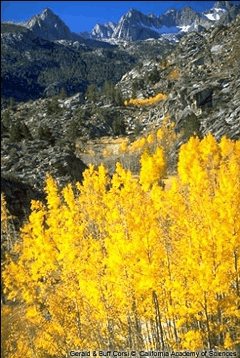
A stand of Aspen trees in California (Courtesy of the California Department of Fish and Game)
YOUNG: Fall is upon us. And for the Rocky Mountain West that means the beautiful gold colors of the aspens. But, increasingly, the aspens are dying. Jim Worrall is a US forest service plant pathologist studying whatÂ’s called Sudden Aspen Decline, with the fitting acronym, SAD. Mr. Worrall, this really is a sad phenomenon, isnÂ’t it?
WORRALL: Yes it is, a lot of people are very concerned about it, and we certainly are, too.
YOUNG: Well, give me a sense of the scale. How big an area is being affected here.
WORRALL: It now occupies about 17 percent of the aspen cover type, or the aspen forest type, within Colorado. It extends up into southern Wyoming, and in northern Arizona and southern Utah, thereÂ’s very similar damage that started a little bit earlier.
YOUNG: What’s going on – why is this happening?
WORRALL: It’s a complex cause – the main inciting factor that we believe is responsible is the major extreme drought we had earlier in the decade. It was very dry during that time and most importantly, it was extremely hot, record-breaking temperatures during that period, so it’s a little bit of a delayed effect from the drought.
YOUNG: When you talk about drought being a factor here, one of the things that pops into my mind is the projections about the increased likelihood of drought in the West. How does climate change relate to this?
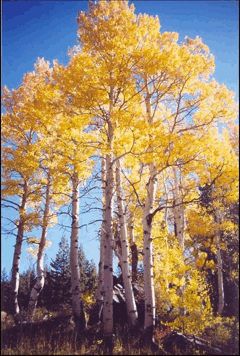
(Courtesy of M. Dupper)
WORRALL: We expect that will lead to a recurrence and probably a worsening of Sudden Aspen Decline. There have also been projections of where aspen is expected to be lost in the early stages of climate change during this century, and itÂ’s been shown that those are areas where we are losing aspen as a result of Sudden Aspen Decline, so itÂ’s not too big a stretch to suggest that Sudden Aspen Decline is the early effects of climate change.
YOUNG: As I understand it, aspen stands – they’re really kind of the same tree, all connected under the soil, right?
WORRALL: ThatÂ’s right. Aspen is a clonal plant, most of the regeneration, most of the stems you see in an aspen stand arose as sprouts or suckers from the roots of a previous aspen tree, and thatÂ’s an important factor in understanding how aspen regenerates, typically.
One of the major problems with the Sudden Aspen Decline is that although the over-stories are dying, the roots donÂ’t seem to be producing suckers to the extent you would hope and that they normally would be if there was a disturbance like a fire or cutting. So, there is concern that some of these aspen stands might not replace themselves.
YOUNG: So, if they donÂ’t replace themselves, will these areas be replaced by other trees, and that isnÂ’t that just kind of the natural succession of the forest?
WORRALL: Yes, I guess that is a successional process, but it means more or less very long-term, semi-permanent loss of aspens on a lot of these sites, which a lot of people donÂ’t want to see.
YOUNG: So, what can you do about this?

A stand of Aspen trees in California (Courtesy of the California Department of Fish and Game)
WORRALL: Well, one thing we can do, we could take action to disturb them in a way that aspen responds to disturbance by producing a lot of sprouts, a new stand, and give them the best chance they have of regenerating before they completely lose all their energy and die out. But, uh, another thing in the long-term is to encourage age diversity in the forest, especially the aspen forest because we know that young stands that had been, say where there’d been cuts or fires 20, 30, 40 years ago – those young stands that have sprouted up to replace the old stands have basically not been affected by Sudden Aspen Decline.
YOUNG: Fire always a big concern in the West. Is this going to add to the potential for fires, having those dead standing trees?
WORRALL: In the short-term, that’s not likely because aspen forests are not very flammable, they hold a lot of moisture and when a fire comes up to an aspen forest it generally slows down or stops. So, even after the over-stories are dead for quite awhile that feature will be retained. But in the long-term, as these stands convert to other forest types, we have conifers or sagebrush, for instance, we won’t have those aspen stands to stop fires as they’re going through the forest. And, so that could be a – over the very long-term – a factor to lead to increased fire spread.
YOUNG: Mr. Worrall, IÂ’m guessing youÂ’re a woodsman, you like to get out there and enjoy these forests. How has this affected the way you are able to relate to aspen forests and enjoy, especially, the fall season?
WORRALL: Well, I have to tell ya, itÂ’s really been great for me, because IÂ’ve been in aspen forests a lot more now, as a result of this.
YOUNG: (Laughs) This gives you an excuse to get out there more! Right, yeah.
WORRALL: Yeah, instead of conifer forests, and the aspen forests are, to me, they are much more beautiful and pleasant to work in.
YOUNG: (Laughs) But, itÂ’s gotta be kind of a bummer to be out among the dying stands?
WORRALL: ThatÂ’s true, it is kind of sad from that point of view. No pun intended.
YOUNG: Jim Worrall, a plant pathologist with the US Forest Service telling us about Sudden Aspen Decline, thanks for your time.
WORRALL: Thank you.
[MUSIC: Daniel Lanois “O Marie” from ‘Acadie’ (Daniellanois.com)]
Language of Landscape
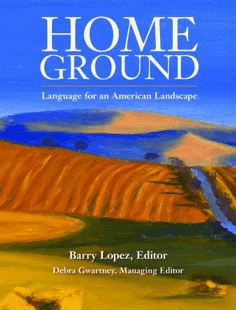
CURWOOD: The landscape out in the West where the aspens are dying is stark, beautiful and idiosyncratic. The particular and iconic features of American geography inspired the book “Home Ground, Language for an American Landscape.” And that, in turn, inspired us to bring you occasional definitions from the book. Today, writer Donna Seaman describes Chop Hills.

SEAMAN: Chop Hills. Nebraskans use the term ‘chop hills’ as an alternative to sand hills; both refer to a ridge of sand, or sand dune, in a region containing a series of hills, either composed of or covered with sand. Nebraska’s Sand Hills form a body of sandy landforms north and northwest of the confluence of the North and South forks of the Platte River and include the marshes the hills nourish. The famed sandhill cranes, wading birds averaging four feet in height with gray plumage, a trumpeting call, and elaborately choreographed mating rituals, frequent the chop hills as a way station on their annual migrations.
CURWOOD: Donna Seaman is a writer and editor based in Illinois. Her definition of Chop Hills comes from the book “Home Ground: Language for an American Landscape,” edited by Barry Lopez and Debra Gwartney.
[MUSIC: Vitamin Piano Series “Brain Damage/Eclipse” from ‘The Piano Tribute To Pink Floyd’ (Vitamin Records - 2005)]
CURWOOD: You can hear our program anytime on our website or get a download for your MP3 player. The address is loe dot org. ThatÂ’s loe dot org. There youÂ’ll also find pictures and more information about our stories. And weÂ’d like to hear from you. You can reach us at comments at loe dot org. Once again, comments at loe dot org. Our postal address is 20 Holland Street, Somerville, Massachusetts, 02144. And you can call our listener line anytime at 800-218-9988. ThatÂ’s 800-218-9988.
A Tale of Two Seals
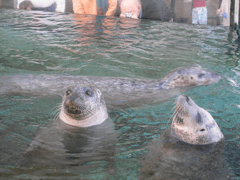
Chuck bobs with his less linguistically-talented family.
[MUSIC: Louis Armstrong “If We Could Talk To the Animals” from ‘The Great Satchmo Plays His Favorites’ (Vintage Gold Masters - 2006 Reissue)]
YOUNG: Dr. Doolittle could talk to the animals, because he learned their language. But it would be much easier if the animals would just learn to speak ours and some have tried. As Living on EarthÂ’s Ike Sriskandarajah found out at the New England Aquarium.
[TALKING VOICES]
SRISKANDARAJAH: Half a dozen kids press their faces against the tanks at the Aquarium – laughing and pointing at the strange and beautiful procession of octopus and jellyfish and shark. And they’re very impressed when I tell them that among all these exotic creatures there once was one – a seal – that could speak English.
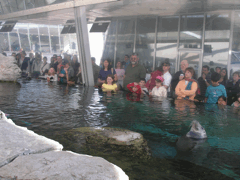
The seal exhibit at the New England Aquarium always draws a crowd. Seal enthusiasts outside the thick glass walls can not hear Chuck's
verbal skills.
KID: Woaah, thatÂ’s so cool!
KID: No it canÂ’t!
KID: It canÂ’t, can it?
KID: ThatÂ’s the coolest thing ever, how does it do that?
KID: Wait are you serious, whatÂ’s his name?
GRAHAM: HooverÂ…
SRISKANDARAJAH: His name was Hoover. ThatÂ’s Cheryl Graham, a lead trainer at the New England Aquarium.
GRAHAM: Hoover was a very famous seal here in Boston. He was on TV, a couple times, and radioÂ… and he was famous for talking.
SRISKANDARAJAH: Yeah, that’s right – this seal could talk. And how he obtained that human skill is a pretty good story.
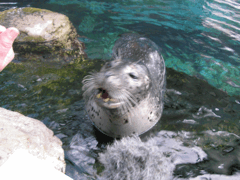
Chuck calls out in two languages; Seal and English.
[MUSIC]
SRISKANDARAJAH: Before he was loved by all of New England, Hoover was all alone. He was an orphaned pup living on the coast of Maine when he was found.
GRAHAM: I believe the guy probably was a fisherman, his name is George Swallow.
SRISKANDARAJAH: George, coming home one night, saw this hungry seal pup and tossed him a few pieces of bait. They disappeared, so George threw him a few more.
GRAHAM: Part of why he was named Hoover was that he ate huge volumes of fish, much like a Hoover vacuum cleaner. He would just suck all the fish down.
SRISKANDARAJAH: When George was all out of herring, he walked down the beach, with Hoover scooting right behind. As he got to his truck George looked at the helpless pup and he couldnÂ’t just leave him, so he drove Hoover home.
GRAHAM: And they had a little salt pond in their backyardÂ…

Chuck bobs with his less linguistically-talented family.
SRISKANDARAJAH: Where Hoover was very comfortable. George would spend hours back there just hanging out with Hoover and chattingÂ…literally.
GRAHAM: And if you kind of picture yourself in George Swallow’s backyard talking to Hoover, you can see George saying, hello there, Hoover, hey there, Hoover, hey, get out of there, Hoover – hey hey, Hoover.
SRISKANDARAJAH: And they lived happily together. George looked out for Hoover, and Hoover looked up to George – becoming better and better at echoing him right on down to the Maine accent. But George knew he couldn’t keep the seal forever. For one thing, Hoover was eating him out of house and herring.
GRAHAM: George said heÂ’s gonna be too big for me and, you know, itÂ’s not practical. So, George brought him here to the aquarium and said, okay, you guys are going to take good care of him.
[MUSIC]
GRAHAM: By the way, he talks.
SRISKANDARAJAH: HooverÂ’s talent went unrecognized at first. In fact, his handlers thought he had a neurological disorder.
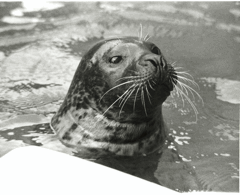
Hoover lived in the New England Aquarium until his death in 1985. His obituary appeared in the Boston Globe.
GRAHAM: So he was just huffing and puffing and he would tip his head back and he would spin in a circle and he would utter these vocalizations. And, at first, the trainers thought that he was having seizures.
[MUSIC]
GRAHAM: Then, they started hearing the word Hoover. [Cheryl impersonating Hoover] Hey, hey, hey Hoover, hello there, get outta here. [Coughing] He had a Maine accent. It always makes me cough [Cough].
SRISKANDARAJAH: And in the aquariumÂ’s archives, thereÂ’s an actual recording of Hoover in action.
MAN: Excuse me, can I sneak in there with my microphone? Thank you.
SRISKANDARAJAH: Back in 1985, a visitor reached his microphone into the seal tank.
HOOVER: Hey, hey, hey, get outta here.
SRISKANDARAJAH: Hoover wasnÂ’t shy, he kept right on talking.
HOOVER: Hey, how are ya? Hey, hey, hey, get over here.
SRISKANDARAJAH: Hoover died shortly after this tape was made. He received an obituary in the Boston Globe – the first and only seal to receive such an honor. They called him the aquarium’s “Ambassador to the World.” Even today, Hoover’s mission lives on…in his grandson.
GRAHAM: We call him Chuck for short, his real name is Chacoda.
SRISKANDARAJAH: Cheryl has been working with HooverÂ’s grandson, honing his vocal talent, for the past 14 years.
GRAHAM: HeÂ’s a very good-looking guy. Yes, heÂ’s a very smart seal.
SRISKANDARAJAH: Chuck glides up to the shore, he looks me right in the eyes and, like a born ambassador, he welcomes me to his land.
GRAHAM: Say whatever you feel like saying.
[CHUCK GROWLS]
GRAHAM: Good.
SRISKANDARAJAH: ItÂ’s obvious I donÂ’t understand, so Chuck and Cheryl try again.
GRAHAM: Listen: Hi.
CHUCK: Hi.
GRAHAM: Good. [laughs] What weÂ’ll ask for is a how are you right now. Listen: How are you?
CHUCK: Hoow hooo hoow arr how are you?
SRISKANDARAJAH: And just in case you didnÂ’t catch thatÂ…
CHUCK: Hoow hooo hoow arr how are you?
SRISKANDARAJAH: I am filled with a feeling you can only get when a seal with saliva and herring guts dripping out of his mouth asks you how youÂ’re doing.
CHUCK: Growl, growl, growl.
GRAHAM: Go ahead, talk. Good.
[WATER SPLASH]
SRISKANDARAJAH: Chuck is not as eloquent as his grandfather, but itÂ’s not for lack of trying. HeÂ’s spent 14 years learning our language. All that effortÂ…it doesnÂ’t quite seem fair.
SRISKANDARAJAH: Have you tried speaking more in seal speak to them?
GRAHAM: Actually, no.
SRISKANDARAJAH: Now, who among us might have the gravelly, guttural pipes to meet Chuck halfway? Who could be our ambassador to the seal world?
[MUSIC: Tom Waits duet with Hoover]
SRISKANDARAJAH: ThatÂ’s Tom Waits, and for Living on Earth, IÂ’m Ike Sriskandarajah.
[MUSIC: Tom Waits “Starving In The Belly Of The Whale” from ‘Blood Money’ (Anti Records - 2002)
CURWOOD: On the next Living on Earth: It's an old profession, opening the irrigation canals to bring water for crops.
ROMO: Zanjeros, ditch-tender...it depends on what part of the country you're from, but everybody has a zanjero. Anywhere you run water, someone has to actually control it because the water doesn't deliver itself.
CURWOOD: A day in the life of a zanjero, next time on Living on Earth.
YOUNG: We leave you this week in the mouth of a dragon.
[STRONG WATER SOUNDS]
YOUNG: Yellowstone National ParkÂ’s DragonÂ’s Mouth is a turbulent hot spring, about 16 feet deep, with water temperatures of 170 degrees Fahrenheit. As the hot water rises to the surface, rising gases cause a pressure explosion in the springÂ’s cavern. It used to be called The Belcher. You can tell why from this recording, made by Jeff Rice for the University of Utah Marriott Library, westernsoundscape dot org.
(EARTHEAR RELATED LINKS:
The Institute of Museum and Library Services funds the Western Soundscape Archive: http://www.imls.gov/
Visit the Western Soundscape Archive: westernsoundscape.org)
YOUNG: Living on Earth is produced by the World Media Foundation. Our crew includes Bobby Bascomb, Eileen Bolinsky, Bruce Gellerman, Ingrid Lobet, Helen Palmer, Jessica Ilyse Smith, Ike Sriskandarajah, and Mitra Taj, with help from Sarah Calkins, Marilyn Govoni, and Sammy Souza. Our thanks today to Dana Chisholm and Alan Tallman.
CURWOOD: Our interns are Quincy Campbell and Nirja Parekh. Jeff Turton is our technical director. Alison Lirish Dean composed our themes. You can find us anytime at loe dot org. I'm Steve Curwood.
YOUNG: And I'm Jeff Young. Thanks for listening.
ANNOUNCER: Funding for Living On Earth comes from the National Science Foundation supporting coverage of emerging science. And Stonyfield farm, organic yogurt and smoothies. Stonyfield pays its farmers not to use artificial growth hormones on their cows. Details at Stonyfield dot com. Support also comes from you, our listeners. The Ford Foundation, The Town Creek Foundation, and The Oak Foundation supporting coverage of climate change and marine issues. The Scole Foundation, supporting social entrepreneurs around the world. Uncommon heroes dedicated to the common good. Learn more at scole dot org. And Pax World Mutual Funds, socially and environmentally sustainable investing. Pax world for tomorrow. On the web at pax world dot com.
ANNOUNCER 2: PRI – Public Radio International.
Living on Earth wants to hear from you!
Living on Earth
62 Calef Highway, Suite 212
Lee, NH 03861
Telephone: 617-287-4121
E-mail: comments@loe.org
Newsletter [Click here]
Donate to Living on Earth!
Living on Earth is an independent media program and relies entirely on contributions from listeners and institutions supporting public service. Please donate now to preserve an independent environmental voice.
NewsletterLiving on Earth offers a weekly delivery of the show's rundown to your mailbox. Sign up for our newsletter today!
 Sailors For The Sea: Be the change you want to sea.
Sailors For The Sea: Be the change you want to sea.
 The Grantham Foundation for the Protection of the Environment: Committed to protecting and improving the health of the global environment.
The Grantham Foundation for the Protection of the Environment: Committed to protecting and improving the health of the global environment.
 Contribute to Living on Earth and receive, as our gift to you, an archival print of one of Mark Seth Lender's extraordinary wildlife photographs. Follow the link to see Mark's current collection of photographs.
Contribute to Living on Earth and receive, as our gift to you, an archival print of one of Mark Seth Lender's extraordinary wildlife photographs. Follow the link to see Mark's current collection of photographs.
 Buy a signed copy of Mark Seth Lender's book Smeagull the Seagull & support Living on Earth
Buy a signed copy of Mark Seth Lender's book Smeagull the Seagull & support Living on Earth

